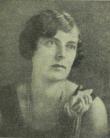As the wife of medical doctor J. M. Sterling Levis, Edith Sterling Levis spent time in the New South Wales towns of Gilgandra and Mudgee during the 1900s and early-1910s. After selling his practice in Mudgee in 1913 Dr Sterling Levis relocated to Sydney and initially practiced out of Marrickville. By the 1920s the couple were living in the affluent eastern suburb of Vaucluse.
Edith Sterling Levis initially became involved in Sydney society, and is recorded as being active in various aspects of amateur theatre as well as charity fundraising. By the mid-1920s she had also begun to publish poetry - her works being read in the Sydney Morning Herald, the Bulletin and Australian Woman's Mirror among other publications. In later years several of her poems were also set to music by local composers Horace Keats, Mirrie Hill, and Englishman Roger Quilter (1877-1953),
During the 1930s Levis garnered additional celebrity through talks and short story recitations broadcast to radio listeners around the country. That same decade also saw two of her original plays produced. The first of these, The Quern (1934) was written in collaboration with C. H. Rolleston. Three years later she wrote another Irish folklore drama, The Spirit Host, collaborating with composer James Brash.
As a writer Levis also developed a considerable reputation for her broad-ranging non-fiction newspapers articles. Founded on meticulous research, these were mostly published in the Sydney Morning Herald between 1930 and at least 1937. Among her topics were the history and meaning of the Swastika symbol, ancient rituals of candlestick, fan and tapestry making, gemstones, Wedgwood pottery, the origins of eating utensils, and various aspects of Irish/Celtic history and folklore. The latter articles were inspired by her travels through the country and time spent researching at Trinity College, Dublin.
 8020877096823450615.jpg
8020877096823450615.jpg
